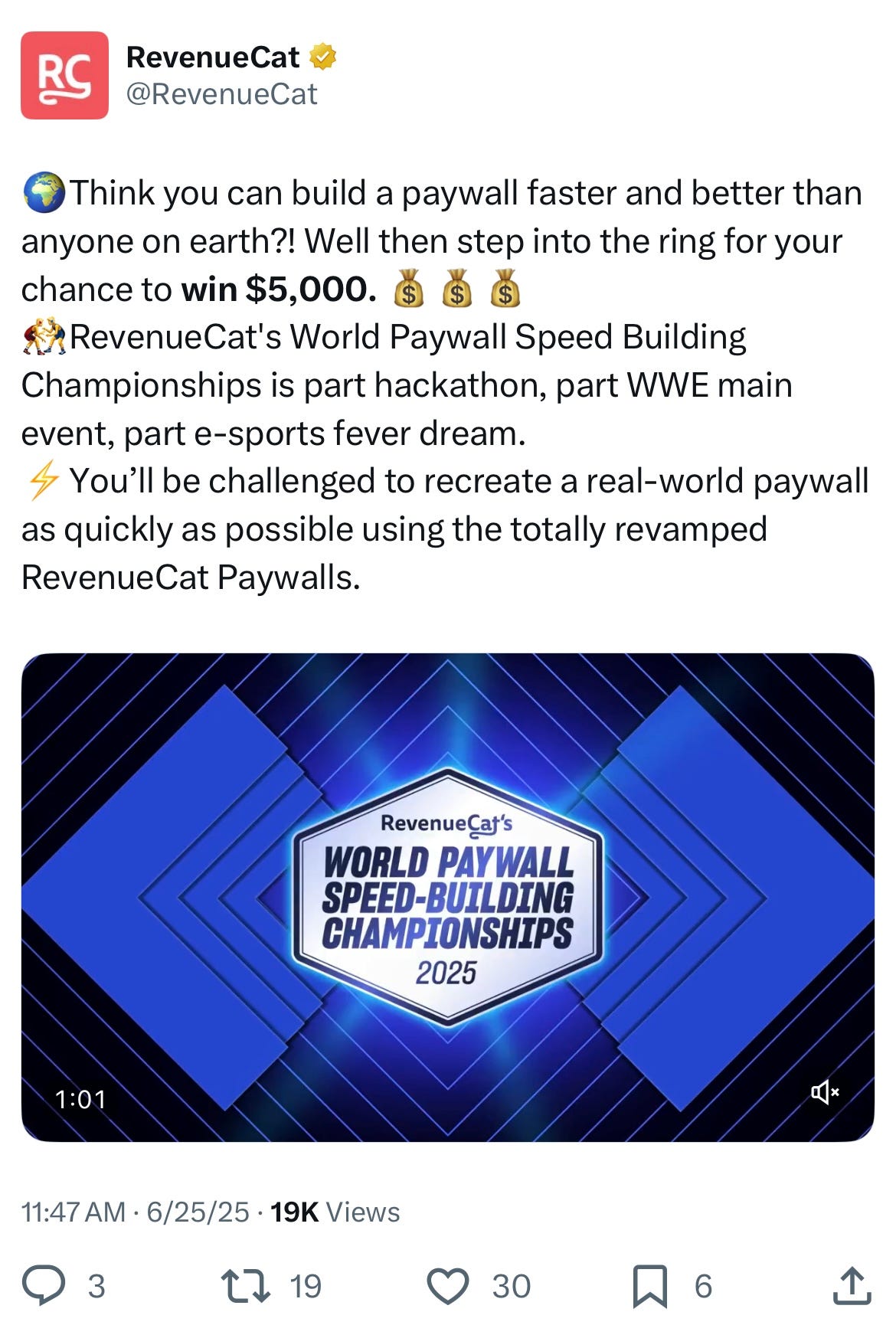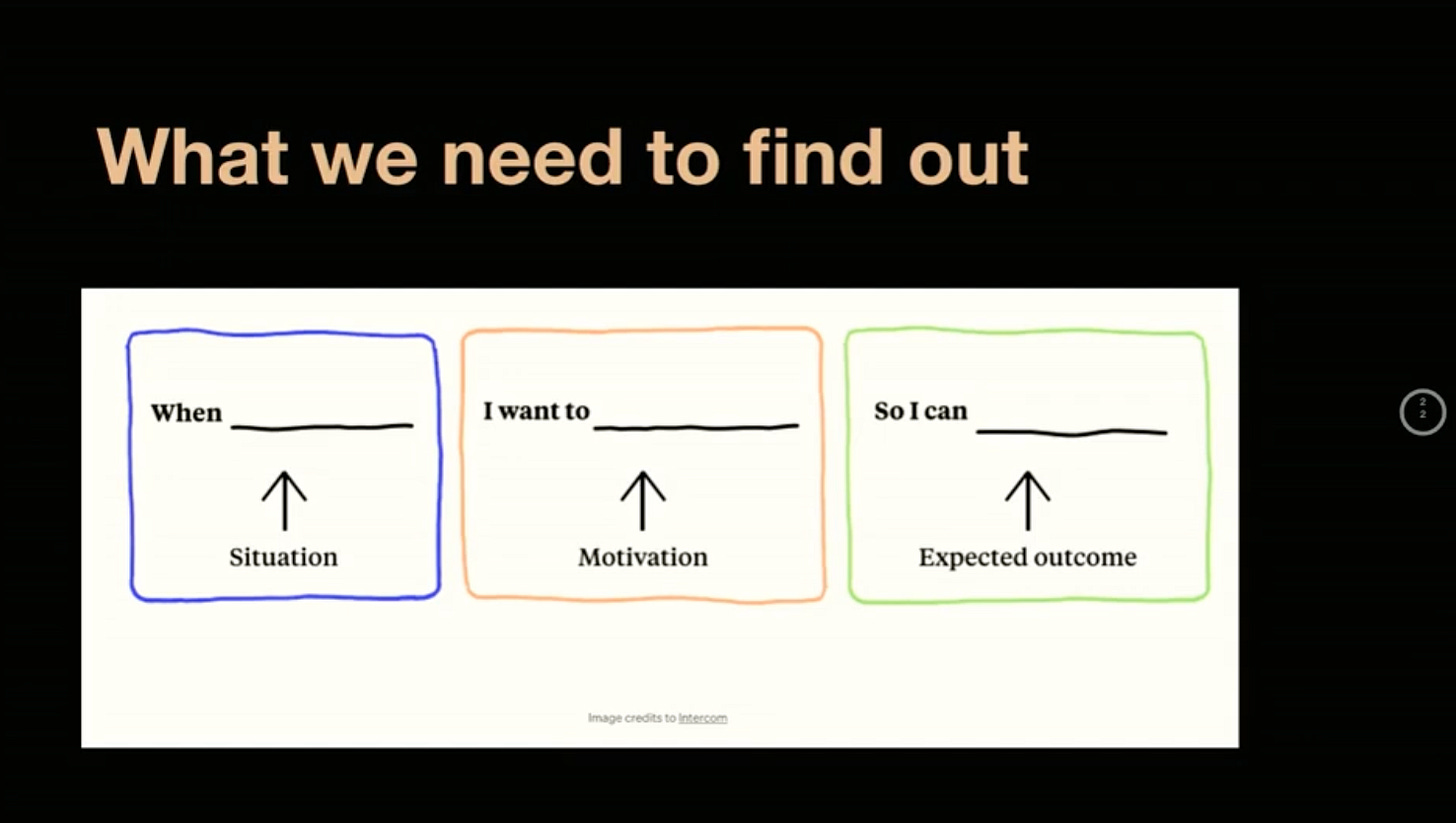Gems from Léa Samrani (VP of Product at Passion) in Unlocking Subscription Growth: A Data-Driven Approach at App Promotion Summit Berlin.
Hi, fellow growth practitioner!
This week, I’m bringing you insights on Onboarding, Activation and Monetization.
I hope these gems will be valuable!
🥇 TOP GEM OF THE WEEK
I like hearing about tactics as much as the next guy.
But I also like a presentation that talks about fundamentals: going back to user research, leveraging job-to-be-done, experimenting on the right areas.
This is what this week’s insights are about.
SPONSORED INSIGHT & RESOURCE
Everybody is too serious.
Another feature announcement? Boring!
But you can always count on RevenueCat to give things a twist.
When they announce the new version of their paywall builder, they do it with an e-sport-like event: the World Paywall Speed-Building Championships.
The top 5 fastest and most accurate builders after the first 2 rounds get an all-expenses paid trip to App Growth Annual in NYC (October 14 - can’t wait!) and will compete for a chance to win $5,000 USD (and show on the Time Square Billboard).
Sign up today and submit your paywall building recording by July 21 to get into the competition!
stage: early
💎 Don't wait to grow before testing - even small apps with 10K MAU can run effective experiments. The key is knowing how to test properly and what to look for, not having a massive user base.
(04:13)
stage: early / growth / scaled
💎 Understanding why users pay for your subscription is the foundation of effective experimentation. Without knowing your users' motivations, you can't generate meaningful test ideas to optimize your subscription funnel.
Use the "Jobs to be Done" framework to understand the expected outcome paying users want from your app. Focus on the "So I can..." part of user responses, as this reveals their true motivation and provides the foundation for effective testing.
(06:44)
You need to ask users what they thought your product would enable them to do, rather than asking about features they like (do not talk at all about your features). This reveals their true motivations and expected outcomes, which is what you need to optimize your subscription funnel.
stage: early / growth / scaled
💎 Conduct 7-10 user interviews with recent subscribers or trial users to understand their motivations. Focus on why they purchased rather than discussing your product features, and document their responses to inform your experimentation strategy.
(09:42)
Léa mentioned it’s best to get very recent trialers/subscribers because they “bought an idea” and don’t yet know about your app.
She shared the example below of JTBD done well by Smart Tales and how it was actioned on. They apparently worked on the whole funnel (ads, app store copy, app store visuals, onboarding flow, paywall, and actual features) and increased their install to subscription by 72%.
stage: early / growth / scaled
💎 Map your subscription growth model to identify where users are dropping off in your funnel. Without understanding this, you risk testing in the wrong places and missing the highest-impact optimization opportunities.
(12:11)
stage: early / growth / scaled
💎 Forget RICE (Reach Impact Confidence Effort): when prioritizing experiments, focus exclusively on potential impact rather than effort. Identify tests with the highest potential impact on your key metrics (typically pre-subscription), then find ways to make them low-effort to implement.
(13:34)
stage: early / growth / scaled
💎 Focus your testing on three high-impact areas: the onboarding funnel, first experience, and first paywall. These areas build perceived value, and the higher the perceived value, the lower the cost perception will be when users reach your paywall.
(14:03)
She recommends to start with the onboarding funnel.
stage: early / growth / scaled
💎 The onboarding flow's purpose is to build perceived value, while the paywall's job is to present cost in relation to that value. The stronger the value perception you create during onboarding, the higher pricing your users will accept at the paywall.
(12:55)
Smart Tales applied JTBD when optimizing their onboarding flow, which led to a +39% increase in conversion from landing to paid subscriber.
stage: early / growth / scaled
💎 The goal is always to increase the perceived value as soon as possible then display the paywall immediately:
For a lot of products, this is done with the onboarding funnel
For some products (the “product-led” ones), this can be done with the first experience.
(17:40)
stage: early / growth / scaled
💎 Test moving your paywall earlier in the user journey. Simply moving a paywall two screens earlier in the experience can increase daily subscriptions by 15%, especially if your onboarding flow already establishes strong value perception.
(18:50)
stage: early / growth / scaled
💎 Transform your paywall copy from feature-focused to job-to-be-done focused. Leading with what users can achieve rather than listing features can increase conversion rates by 54% or more.
(21:29)
stage: early / growth / scaled
💎 Adding a shorter subscription option can actually increase purchases of your yearly plan. It’s counterintuitive but it can increase both conversion rates and average revenue per user through effective price anchoring.
(21:55)
This can depend on the app vertical, but it’s one of the reasons the “Blinkist timeline” was not always a win (at least when defaulting to yearly).
💎 The sequence of your experiments matters significantly. A test that fails at one stage may succeed after you've implemented other improvements, particularly when testing pricing changes after enhancing value perception during onboarding.
(23:32)
So true.
The example she shared is still the same as above, where their price increase test performed better on the “After” screen but had lost on the “Before” screen.
Want more takes from Léa? Check out Growth Gems #89 👇
See you next time.
Stay curious!
— Sylvain
Chief Insights Miner at Growth Gems ⛏️
(Fractional) Head of Growth at Reading.com
Growth Consultant/Advisor for high-potential subscription apps (hit reply if you want to chat - bonus if you’re in Education, Meditation & Cooking categories)
🔗 Source:












